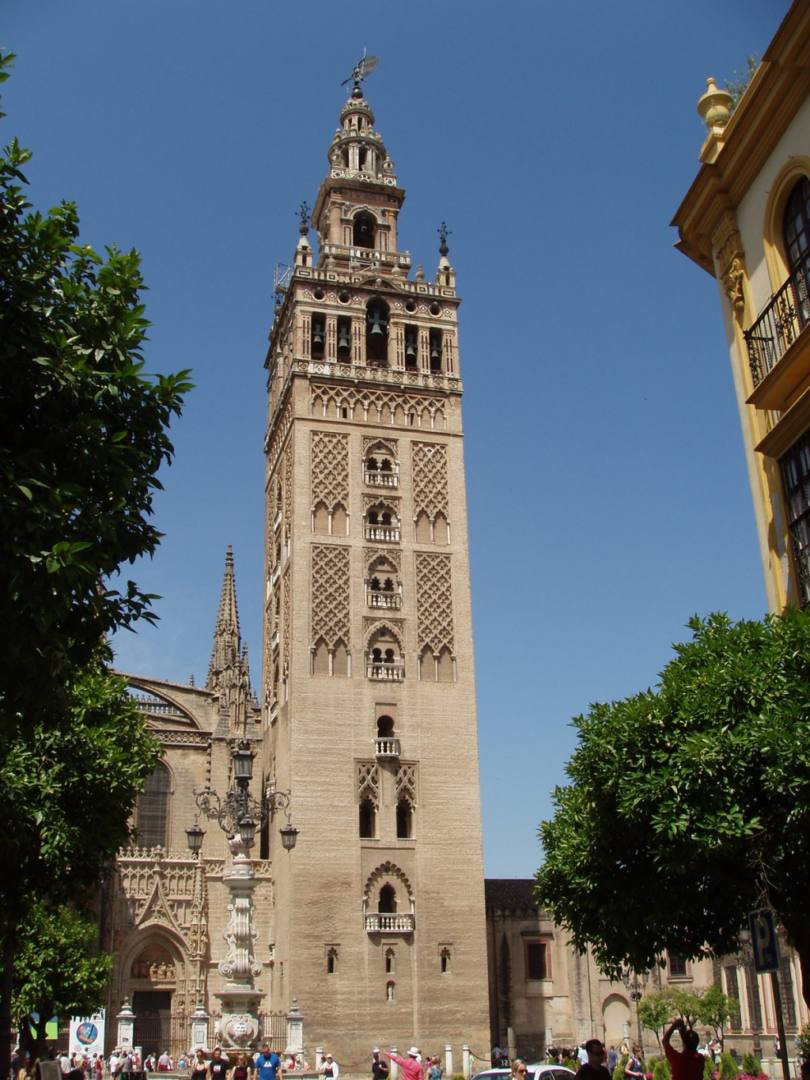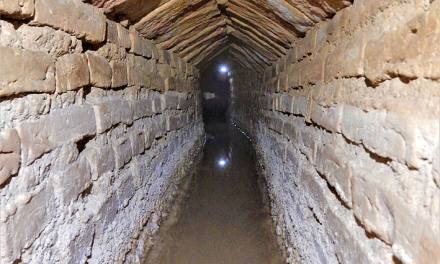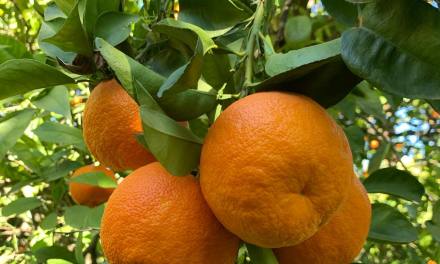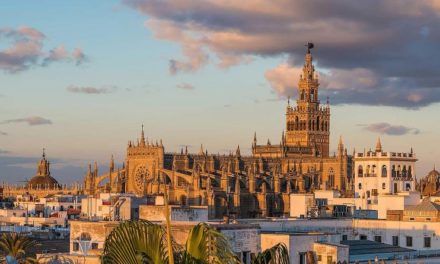SEVILLE HISTORY. THE CITY OF SEVILLE
Seville has a rich and fascinating history. The Romans governed the whole of Spain for more than six centuries. Their first colony was Italica which may still be visited today.
The Romans changed the face of the countryside and towns, building aqueducts and long straight roads to link the major towns. Today some of the best preserved artifacts from this period can be found at the city’s magnificent Archaelogical Museum.
But it was the Moslem civilization which was to have the most lasting impact on the city. Their reign lasted for nearly 800 years in Andalucia from 711 until 1492 when the Catholic monarchs defeated the Moslem kingdom of Granada.
Some of the city’s most magnificent buildings stand as a legacy to this era, including the Torre del Oro, Torre de Plata, Giralda, Patio de los Naranjos, the area of Triana, the Macarena Walls and the Alcazar. Later the the mudejares used their skill to create beautiful Moorish-style buildings, such as the Palacio Pedro I, part of Seville’s Reales Alcázares. There are several Mudejar churches dating from this period, including the Iglesia de San Marcos, the Iglesia de Santa Catalina and the Church of San Pedro.
Interestingly, Mudejar architecture continued long after the Moslem period, one of the best examples being the Casa de Pilatos, one of the most beautiful buildings you can visit in Seville. City walls and gates offer an insight into the history over the ages.
After the fall of Granada to the Christians, Spain entered an era of expansion and prosperity. The conquest of the New World made Seville one of the most affluent cities in Europe, but much of this wealth was squandered on wars by the Hapsburg kings. The 13 year War of the Spanish Succession saw Bourbons on the throne in place of the Hapsburgs and, under the Treaty of Utrecht, the loss of Gibraltar to the British. Later ties with France dragged Spain into the Napoleonic Wars.
Following the Battle of Trafalgar, the Spanish King, Carlos IV abdicated and Napoleon Bonaparte placed his brother, Joseph on the Spanish throne. The Peninsula War ensued and, with British help, the French were driven out of Spain. After the Bourbon restoration, Spain weakened by further strife, began to lose her colonies.
By the 18th century, Spain had fallen into economic decline and in the 19th and early 20th centuries poverty led to political conflict and ultimately to civil war.
Many of the more recent historic buildings date from the 1929 Ibero-American Exposition of 1929, including the Plaza de España and the Parque Maria Luisa.

In 1992 this event was repeated when Expo took place again in Seville, attracting thousands of visitors from around the world.
UNESCO WORLD HERITAGE SITES IN SEVILLE
What UNESCO says: “Together these three buildings form a remarkable monumental complex in the heart of Seville. The cathedral and the Alcázar – dating from the Reconquest of 1248 to the 16th century and imbued with Moorish influences – are an exceptional testimony to the civilization of the Almohads as well as that of Christian Andalusia. The Giralda minaret is the masterpiece of Almohad architecture. It stands next to the cathedral with its five naves; the largest Gothic building in Europe, it houses the tomb of Christopher Columbus. The ancient Lonja, which became the Archivo de Indias, contains valuable documents from the archives of the colonies in the Americas.”
* The Cathedral

What there is to see: a huge, imposing basilica, built over a mosque, whose highlights include a massive gold altarpiece, paintings by Murillo and a magnificent tower, Giralda, offering superb views over the city.
* The Alcazar
What there is to see: a mish-mash of architectural styles and periods, making up a fascinating tour through history – various buildings featuring courtyards, baths, pools, tapestries and intricate carvings, plus a lush garden. Exhibitions, and outdoor plays and concerts in summer.
* The Archivo de Indias
What there is to see: a 16th-century building, formerly the stock exchange, housing 40,000 documents and maps (including fascinating city plans) referring to voyages to the New World, covering three centuries; an extraordinary research resource. Exhibitions.
CITY WALLS AND GATES
As you arrive in the city, look out for remnants of ancient stone walls marooned in the centre of busy roads, plus an impressive, well-preserved 400-metre section in Macarena, near the Andalucian parliament building. These are the remains of the city walls, or murallas, dating from the 12th century – Seville was once the most strongly fortified city in Europe.
It was the Romans, probably under Julius Caesar, who constructed the first city defences. But the Almoravids, Moors who ruled Andalucia in the 11th and 12th centuries, were responsible for the simple but effective 6km-long walls. They were designed to defend the city against both enemy attacks and frequent floods from the river Guadalquivir.
The murallas had 166 watchtowers and nine gates, with a sentry path along the middle. Today only three gates remain: Puerta de Córdoba, Puerta Macarena and Postigo del Aceite, while towers you can see include the Torre de Oro (Golden Tower), by the river, the Torre de Plata (Silver Tower) and the Torre Blanca (White Tower).
Puerta de Córdoba is a typical Moorish horseshoe arch. St Hermenegildo was martyred there in 578 and his church is behind the gate.
Puerta Macarena, in front of the church of La Macarena, dates from the 2nd century AD. It was rebuilt after the Lisbon earthquake in the 18th century.
Postigo del Aceite was where oil and fat entered the city. It was built in 1107 and reformed in 1573.
You’ll notice other place names throughout the city where gates once stood: Puerta Osario (named after a cemetery), Puerta de la Carne (near a slaughterhouse), Puerta de Jerez (where the road to Jerez started; look for the inscription taken from the gate, in the corner of the plaza), Puerta de Carmona (named after the road to Carmona, also where the water channels from Carmona supplying the city arrived), Puerta Real (originally called Goles; latterly named after when either Felipe II or St Fernando entered the city), and Postigo de Carbon (c/Santander, related to the weighing of coal at the gate).










